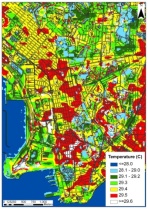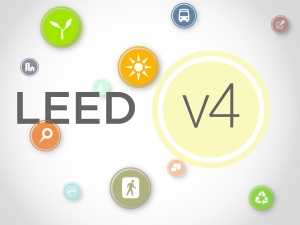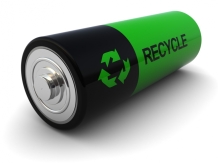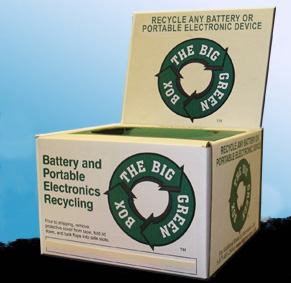The Blog is Moving!
 To all of our dedicated readers and faithful followers, we have moved the Healthy Buildings Blog location from this wordpress-based URL to our company’s website. You can now find us at:
To all of our dedicated readers and faithful followers, we have moved the Healthy Buildings Blog location from this wordpress-based URL to our company’s website. You can now find us at:
WWW.HEALTHYBUILDINGS.COM/BLOG
Thank you again for all of your love and attention! This URL will de-activate on July 15th.
Heat Island and Healthy Buildings
Albedo? Heat Island? Solar Reflective Index?
These are some terms floating around the industry relating to environmental health and energy efficiency. The heat generated and absorbed by commercial and industrial areas has a tendency to get trapped in an “island-like” manner surrounding the buildings. These areas can be so much hotter than the surrounding environments that it effects growing seasons, air quality, energy efficiency and ecosystem health. This increase in temperature not only harms the local animal and plant life, but it also makes the buildings’ HVAC and other equipment work much harder than required.
The EPA has reported that, “the annual mean air temperature of a city with 1 million people or more can be 1.8–5.4°F (1–3°C) warmer than its surroundings. In the evening, the difference can be as high as 22°F (12°C). Heat islands can affect communities by increasing summertime peak energy demand, air conditioning costs, air pollution and greenhouse gas emissions, heat-related illness and mortality, and water quality.”
“Summer land surface temperature of cities in the Northeast were an average of 7 °C to 9 °C (13°F to 16 °F) warmer than surrounding rural areas over a three year period, the new research shows. The complex phenomenon that drives up temperatures is called the urban heat island effect.” – Dr Marc Imhoff, NASA
But wait, there is good news! There are a plethora of reasonable efforts that can help lower the impact of spring and summertime heat islands. Some common efforts within the LEED and green building community are white roofs, or roofs with a high albedo or SRI value. Albedo and SRI are related to the ability of a surface to reflect light and heat off and back out of the immediate area. Dark surfaces, such as asphalt and dark roofing material absorbs heat and increase the effect of the dreaded heat island. Buildings concerned about reducing their impact on the heat island may replace their roof with a white material, coat their existing roof with a high SRI value, or even add a garden (green roof)! Not only does this increase the efficiency of the building’s energy systems, but it can increase the air quality and productivity of the micro-climate altogether.
Job Offerings @ Healthy Buildings

In an effort to expose our open positions to as many viable candidates as possible, the Healthy Buildings’ Blog will be used as an update for all current job openings. It is our goal to gather the greatest talent, sharpest minds, and compassionate hearts as we cultivate a work environment where we function together in strong teams to help increase the value of buildings while supporting a healthy ecosystem. Here is what we have available this month!
Environmental Field Technician in DC Metro Area
Indoor Air Quality Techncians / Project Managers are responsible for the execution of all activities related to customer service in field operations including, indoor air quality testing and basic HVAC inspection including:
- Interact and communicate with clients on environmental technical matters,
- Collation and accounting of field samples,
- Knowledge of equipment, software, and operating systems necessary for the recording and downloading of field equipment,
- Ultimately responsible for the quality and timely collection of field data,
- Participate in technical operations meetings for the improvement and efficiency of field operations,
- Respond to client field inquiries in a prompt, knowledgeable, and courteous manner,
- Adhere to all aspects of the health and safety program.
Technical Report Writer / Office Manager in South Orange, New Jersey
Manage the report production process as well as ensure the smooth operation of the South Orange, New Jersey office by performing the following duties and tasks:
- Manage the entire report production process including writing, revising, and electronic delivery to the client
- Receive and respond to client inquiries regarding technical reports and technical questions
- Resolve all problems related to technical report issues
- Review report templates and impliment changes as necessary
- Perform clerical duties in relations to report production, client management, field work coordination, purchasing, and invoicing
- Ensure the office is running smoothly and efficiently
- Other duties as assigned.
Technical Sales Representative in Orange County/Los Angeles Area
- Develop business in the commercial, multifamily, and institutional real-estate industries
- Market the following technical services: indoor environmental testing, energy audits, building commissioning, high performance building solutions, and LEED certification
- Generate project proposals and respond to RFPs and RFQs
- Promote utility-funded energy efficiency programs
- Develop project budgets
- Conduct market research and prospect to identify new opportunities
- Perform a wide array of tasks to meet aggressive timelines that include various internal Team members and external partnerships
LEED v4 – A Healthy Update
Recently, the USGBC offered a series of educational webinars about the latest developments regarding LEED v4. The USGBC is still looking for projects to participate in the v4 BETA program. If you are interested in registering a project with the v4 BETA program, you may do so until Greenbuild in November. Some perks in participating in the v4 BETA program include: first look at reference guides, certification process, test new LEED Online forms, provide feedback to the USGBC and GBCI teams, up to three CIRs, free promotion through USGBC Marketing, project recognition in Greenbuild 2013, assigned USGBC staff member to project, and many more. If you have a project currently registered under v2009 and would like to upgrade to v4, you can upgrade at no cost. Additionally, should your project demonstrate better performance under v2009, the USGBC will allow it to be reverted back from v4 at no cost.
If you are considering the v4 BETA program, some space types that the USGBC is looking for include schools, residential, hospitality (hotel), and campus projects. Please contact us if you desire more information!
Earth Day – A Time for Reflection
Today, on Earth Day, we take a step back from our daily business to try and understand WHY it is that we do what we do. Some say that what you do is not as important as why you do it, and I believe there is no greater day for this reflection. Throughout our daily business at Healthy Buildings, it is our intent to make buildings healthier, more efficient, and more valuable. These efforts are all grounded in creating harmony between man, nature, and civilization – but this movement didn’t begin out of thin air.
The massive “Spaceship Earth” that we occupy is much more delicate and vulnerable than we had ever expected. The beginning of this understanding was sparked through the Apollo explorations. Check out this beautiful video that displays a turning point in the understanding of the Earth.
It’s tiny out there…it’s inconsequential. It’s ironic that we had come to study the Moon and it was really discovering the Earth.
~ Bill Anders, Apollo 8
When the Apollo astronauts took the first look at the Earth from space, a ripple of awareness and understanding spread throughout the human consciousness. We live on a floating rock that nurtures life unconditionally. The new perspective gifted by these brilliant space explorers birthed a new respect for the Earth and has continued ever since.
I think the one overwhelming emotion that we had was when we saw the earth rising in the distance over the lunar landscape . . . . It makes us realize that we all do exist on one small globe. For from 230,000 miles away it really is a small planet.
~ Frank Borman, Gemini 7 & Apollo 8
This adventure was no mistake, it is no coincidence that this event changed the general understanding of the Earth and the universe as a whole. I believe that it is our responsibility to ensure we maintain the health of the Earth. If this effort in itself is not inherently convincing, may it be for the survival of human society – for at the very least we can rationalize these efforts for our own well being. The basis of who we are as a civilization is connected directly to how we interact and treat the Earth, because this is a reflection of how we treat ourselves. Let us continue this flowering understanding of our beloved Earth and continue to support harmonious human interaction.
Handling E-Waste: Battery Recycling Programs
- Credit: © Shutterstock
Americans buy nearly 3 billion dry-cell batteries every year to power cell phones, radios, toys, remotes, watches, laptops, and portable power tools. Batteries contain a number of heavy metals and toxic chemicals and the dumping of batteries has raised concern over the risks of soil contamination and water pollution.
The battery of the future will have more capacity, more conductivity, more flexibility and will be fully compostable. This is just one of many green dreams that will help improve the harmony of industry and environment. The first commercially available battery came to market in the 1960’s, and since then there have been incredible strides in their applicability and longevity. What has been lacking in these technological advancements is environmental compatibility and dispensability. Below is a video of new battery technology that may adhere to present day problems with e-waste. Take a gander at the “Super Supercapacitor” by Brian Davis.
Until the battery market develops and supports a new eco-friendly battery, there are a few different options for recycling or properly disposing of these toxic items. One available web-based company, Call2Recycle, has a program that collects e-waste on-site anywhere in the United States as well as Canada. Additionally, there are drop-off stations that can be utilized for personal disposal. Businesses, retailers, communities and public agencies are able to participate in this program for free! Shipments are sent to a recycling facility and usable materials are then upcycled to create new products or materials.
“BUY IT, FILL IT, SHIP IT,” is the motto for The Big Green Box, used to safely collect, store, and ship away harmful batteries and e-waste. The Big Green Box is available for commercial or residential spaces, pre-constructed to increase the ease of the disposal process. Once the box is filled, simply drop The Big Green Box off at any FedEx location or have your current FedEx driver take the box. The price of shipping to and from your location is included in the price of the box.
Aside from these great recycling options, one way to reduce your e-waste stream is to buy rechargeable batteries. About one in five dry-cell batteries purchased in the United States is rechargeable. Over its useful life, each one may substitute for hundreds of single-use batteries. Thank you for reading and don’t forget to save and recycle!
How Efficient is Your Vehicle? LEED and the ACEEE
As one explores the USGBC and the various LEED rating systems, a realization occurs that without third-party programs, certifications, policies and verification…there would be no LEED as we know it today. These third-party programs help develop the framework that supports LEED on a universal scale. One instance of this is found with the accepted green cleaning products, highlighted in a previous post about Green Seal and Environmental Choice. As more third party programs develop, LEED becomes more stringent and transparent simultaneously.
the American Council for an Energy-Efficient Economy (ACEEE) has developed a database of all vehicles and ranks them by the associated “Green Score”. This score is determined by pollution during manufacturing, production and distribution of the required fuel type, exhaust emissions, fuel efficiency, hydrocarbons and much more. This information is reported through the U.S. Environmental Protection Agency and the California Air Resource Board. The top vehicle in 2013 scored a 58 and the average is a 35. The monsters of the road average at a score of 15, what hogs!

Photo: http://www.aceee.org
LEED for Existing Buildings, Operations and Maintenance (EBOM) reserves a potential for 15 points for promoting alternative forms of transportation for building occupants. These 15 points are potentially 25% of the points needed for a building to reach LEED Gold certification! The Green Book of vehicles, created by ACEEE, is the database holding the scores for each vehicle on the road today. Points under LEED EBO&M are captured by determining how many occupants use alternative forms of commuting, such as carpool, telecommuting, biking and even running (yes, some people exercise their way to work!). Drive-alone occupants may still fall under the “alternative forms of transportation” if their vehicle meets the ACEEE Green Score of 40 or more.
Greenercars.org, a derivative of ACEEE, has a wealth of information including the meanest and greenest vehicles of 2013, green driving tips to improve fuel efficiency, and market trends regarding vehicle manufacturers, technology, and sustainability. Find out how sustainable your vehicle is today!
California ENERGY STAR Benchmarking Update
In California on July 1st, 2013, AB 1103 will require building owners and operators to disclose energy benchmarking data to their prospective full building lessees, buyers or lenders.
Energy performance ratings are a critical management tool for evaluating how efficiently a building is using energy compared to similar buildings nationwide. Buildings with superior performance are eligible to earn EPA recognition. The ENERGY STAR Label is awarded for facilities achieving the top 25 percent (a score of 75 or higher) of performance ratings nationally, without compromising comfort or services.
Healthy Buildings’ Energy and Resources Group completed over 12 Million square feet of Energy Star Benchmarking and Energy Audit Services in 2012.
Healthy Buildings uses the U.S. Environmental Protection Agency’s (EPA) ENERGY STAR Portfolio Manager Program to benchmark and track utility data (energy and water usage). Healthy Buildings conducts thorough building analyses to capture all energy and utility information to better understand how a building compares to similar buildings nationwide. This allows Healthy Buildings to:
- Verify building energy performance
- Monitor energy and water costs
- Determine energy performance ratings
- Benchmark facilities relative to past performance
- View percent improvement in weather-normalized source energy
- Conduct portfolio-wide analyses
- Determine LEED EBOM eligibility
Once verified by one of our Professional Engineers, buildings with exceptional energy performance can apply to earn the ENERGY STAR Label. Let us know if you would be interested in Healthy Buildings helping with Energy Star Benchmarking.
Learn more about our Energy and Resources Department by contacting Nicholas Kiefer (949) 450 1111 nkiefer@healthybuildings.com for more information..
AB 1103 Update & FAQ – BOMA California
AB 1103 BENCHMARKING RESOURCES/FAQ
This is an update provided by BOMA California. The Building Owners and Managers Association of California is a federation of all eight metropolitan BOMA local associations. Visit them online at http://www.bomacal.org
The Nonresidential Building Energy Use Disclosure Program kicks in this summer. This is the mandatory Energy Star disclosure law we have been working on for over five years now. The present effective date of the regulations is July 1, 2013 for large buildings (more than 50,000 square feet); January 1, 2014 for medium buildings (more than 10,000, and up to 50,000 square feet); and July 1, 2014 for small buildings (5,000 up to 10,000 square feet).
Basically, anytime you finance, sell, or lease a whole building, you are required to run the Energy Star numbers and provide that information to the other party in the transaction as well as the Energy Commission. The Energy Commission staff is working to provide online resources to help you comply with this new law. Here are several items you can find already online:
- Final AB 1103 Regulations
- AB 1103 Disclosure Summary Sheet
- Sample Statement of Energy Performance
- Sample Data Checklist
- Sample Facility Summary
They are also working on a “Frequently Asked Questions” document and would like our input. If, after reading through the materials, you are unclear on how to comply with the law, or if there are lingering questions, please let us know and we will pass along to the CEC.
Disclaimer: Healthy Buildings claims no responsibility of the text in this post, we are simply sharing this pertinent information provided by BOMA-CA!
Green Spring Cleaning
As Winter winds down and the days progressively get warmer, the dreaded Spring cleaning season approaches quickly. Beyond finding new sustainable ways to throw out recycle old junk, it is important to consider the cleaning products and chemicals that are used indoors. Cleaning practices should not compromise health and safety, and raising the social consciousness around the cleaning products we use will not only improve our indoor air quality, but it won’t sell out the environment in the process.

The USGBC‘s LEED (Leadership and Education in Environmental Design) Certification for existing buildings promotes and encourages sustainable, environmentally conscious cleaning products and materials. LEED is a compilation of various codes, standards, suggested certifications, and top-tier regulations on building practices from construction to management and demolition. Two of the specific certification programs that LEED promotes for cleaning products are Green Seal and EcoLogo, or Environmental Choice. These certification programs focus on products and materials that are less toxic to the environment and use resources more efficiently than conventional products. The human and environmental health benefits of each product varies, but a growing awareness on the availability of these cleaning products perpetuates ingenuity.
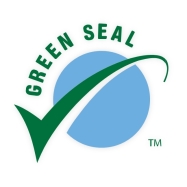 Now, you may be asking, “what is so awful about conventional cleaning products and chemicals?” Great Question! Aside from high concentrations of VOCs, here are a few other reasons to switch up your cleaning supplies:
Now, you may be asking, “what is so awful about conventional cleaning products and chemicals?” Great Question! Aside from high concentrations of VOCs, here are a few other reasons to switch up your cleaning supplies:
1. Labels are often difficult to read and generally misunderstood. Words like “non-toxic” and “natural” can be misleading without a third-party verification. It is important to research these products and be aware of what chemicals are brought indoors.
2. Manufacturers are only required to list the “active disinfectants” or ingredients that are known to be hazardous, which is speculative in itself. Certain ingredients are considered a company privilege and are not always publicly disclosed. Simply because a product makes a claim about sustainability does not guarantee its validity.
3. “Antibacterial” products don’t always protect human health. Sterilizing a home as if it is a hospital may have many adverse and often unintended consequences. Antibacterial products target bad bacteria as well as good bacteria that helps with proper digestion of food, fighting off diseases and viruses, as well as keeping our bodies in a healthy state.
So next time you are shopping for cleaning products, consider your health and your environment. Take a few extra minutes to consider what you spray indoors and how it affects our air and water. Not every product has a sustainable substitute, but making a conscious choice goes a long way.


